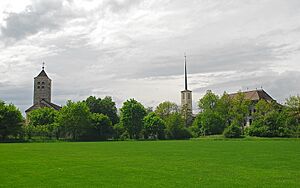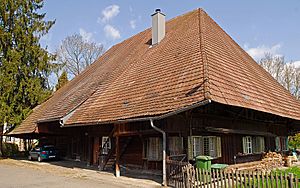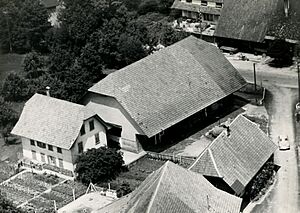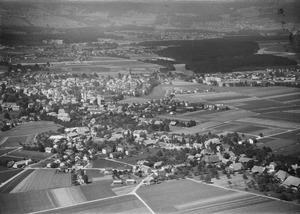Derendingen, Switzerland facts for kids
Quick facts for kids
Derendingen
|
||
|---|---|---|
|
||
| Country | Switzerland | |
| Canton | Solothurn | |
| District | Wasseramt | |
| Area | ||
| • Total | 5.63 km2 (2.17 sq mi) | |
| Elevation | 439 m (1,440 ft) | |
| Population
(Dec 2020 )
|
||
| • Total | 6,592 | |
| • Density | 1,170.9/km2 (3,032.5/sq mi) | |
| Postal code |
4552
|
|
| Surrounded by | Biberist, Deitingen, Gerlafingen, Kriegstetten, Luterbach, Oekingen, Subingen, Zuchwil | |
Derendingen is a town in Switzerland. It is located in the canton of Solothurn. This town is part of the Wasseramt district.
Contents
What is the History of Derendingen?
Derendingen was first written about in 1264. Back then, it was called Teradingen. For a long time, it was mostly a farming community. In the 1860s, it became a place known for making textiles. Today, a group of houses called Elsässli is considered an important historical site.
Where is Derendingen Located?
Derendingen covers an area of about 5.62 square kilometers (2.17 sq mi). A big part of this land, about 39.1%, is used for farming. Forests cover about 26.7% of the area. Buildings and roads make up about 32.6% of the land. A small part, 1.4%, is rivers or lakes.
The town is found in the Wasseramt district. It sits near the lower part of the Emme river.
Some nearby towns are thinking about joining together in the future. These towns include Biberist, Luterbach, Bellach, Langendorf, and Solothurn.
What is Derendingen's Coat of Arms?
The town's official symbol, its coat of arms, shows a silver shield. On the shield are three red stripes. A blue fish swims across these stripes.
How Many People Live in Derendingen?
Derendingen has a population of about 6,592 people. About 26.2% of the people living there are from other countries. Over the last 10 years, the population has grown by about 3.8%. This growth is mostly because more people have moved into the town.
What Languages are Spoken in Derendingen?
Most people in Derendingen speak German. About 85.1% of the population uses German. The second most common language is Italian, spoken by about 6.0% of people. Albanian is the third most common, spoken by about 2.3%. A few people also speak French or Romansh.
How Has the Population Changed Over Time?
The number of people living in Derendingen has changed a lot over the years. You can see how the population has grown and shrunk in the chart below:

What is the Economy Like in Derendingen?
In 2010, the unemployment rate in Derendingen was 5.1%. Many people work in different areas:
- Primary sector: This includes jobs like farming. There were 24 people working in this area.
- Secondary sector: This includes jobs in factories and construction. About 675 people worked here.
- Tertiary sector: This includes jobs in services, like shops, offices, and healthcare. About 1,012 people worked in this sector.
Many people who live in Derendingen travel to other towns for work. Also, many people from other towns come to Derendingen to work. About 15.7% of workers use public transportation to get to their jobs. Most, about 56.8%, use a private car.
What Religions are Practiced in Derendingen?
According to a 2000 survey, people in Derendingen follow different religions:
- About 33.6% are Roman Catholic.
- About 35.1% belong to the Swiss Reformed Church.
- About 8.07% are Islamic.
- About 16.35% do not belong to any church.
- Smaller numbers of people belong to other Christian churches, Orthodox churches, or other religions like Buddhism and Hinduism.
What About Education in Derendingen?
Many adults in Derendingen have finished their education. About 36.8% have completed high school. About 9.6% have gone on to higher education, like a university.
What is the School System Like?
In the 2010-2011 school year, there were 558 students in Derendingen's schools.
- Kindergarten: Young children can attend two years of non-required kindergarten. There were 114 children in kindergarten.
- Primary School: Students must attend six years of primary school. There were 444 students in primary school.
- Secondary School: After primary school, students go to three years of lower secondary school. After that, they can choose to go to advanced schools for three to five more years. All students from Derendingen go to secondary school in a nearby town.
See also
 In Spanish: Derendingen para niños
In Spanish: Derendingen para niños










